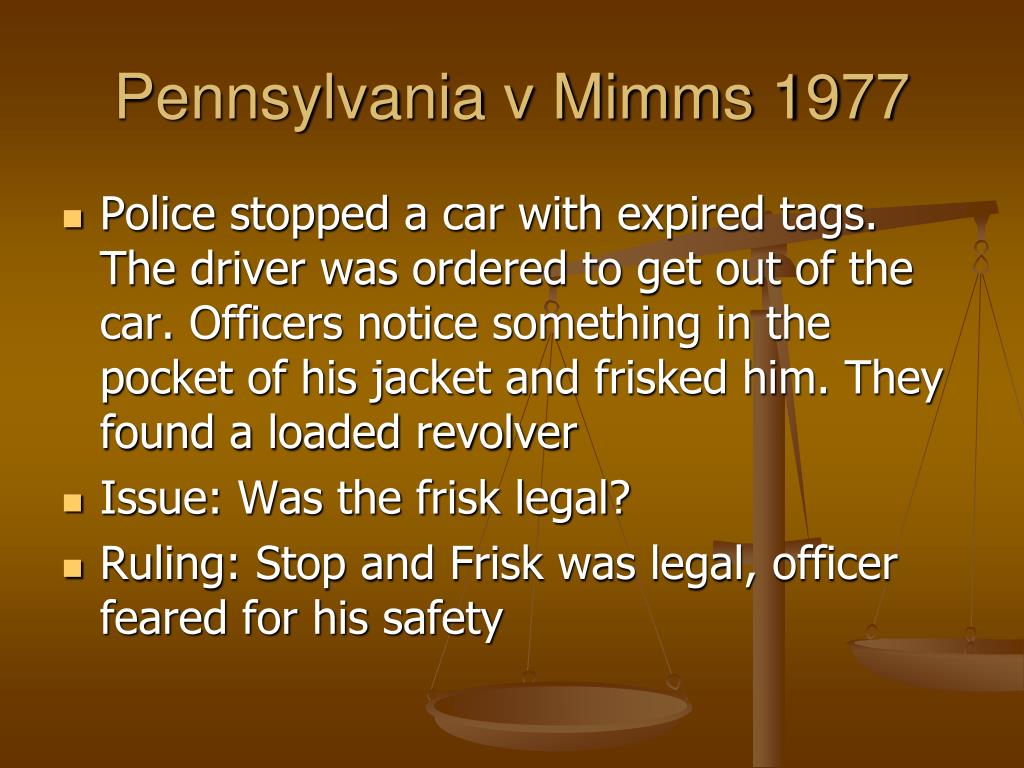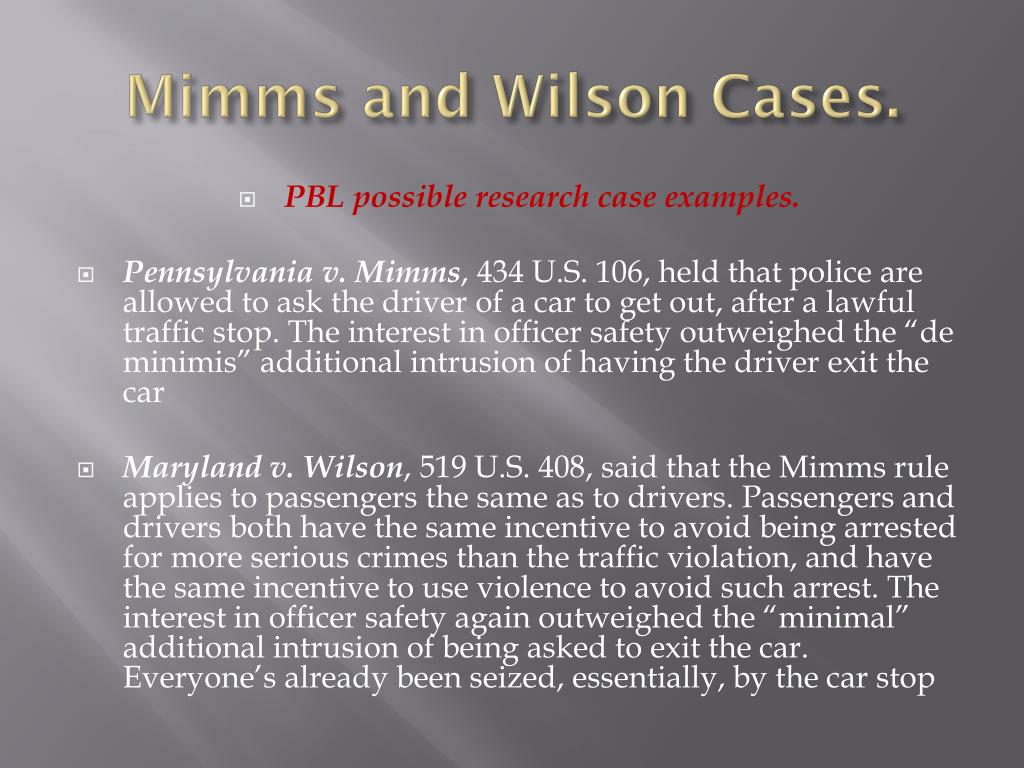Can a routine traffic stop escalate into a constitutional question, and what rights do law enforcement officers have during such encounters? The Supreme Court's decision in Pennsylvania v. Mimms fundamentally reshaped the landscape of police authority during traffic stops, establishing a precedent that continues to influence legal interpretations today.
The legal saga of Pennsylvania v. Mimms began on a seemingly ordinary day in Philadelphia. After police officers observed Harry Mimms driving with an expired license plate, they initiated a traffic stop. Following standard procedure, one of the officers requested that Mimms exit the vehicle. This seemingly innocuous request would become the central point of contention in a case that would eventually reach the highest court in the land.
As Mimms stepped out of his car, the officer noticed a suspicious bulge under his jacket. A subsequent pat-down, conducted for officer safety, revealed a loaded revolver. Mimms was subsequently arrested and indicted on charges of carrying a concealed weapon and possessing an unlicensed firearm. This arrest would ultimately lead to a complex legal battle.
- Human Latch Horror Gary Mars Terrifying Transformation
- Catherine Mooty Age Net Worth Everything You Need To Know
The case quickly moved through the lower courts. Mimms was initially convicted in the Court of Common Pleas in Philadelphia. However, the Pennsylvania Supreme Court reversed the conviction, arguing that the gun had been seized as a result of an unlawful search. This divergence in legal opinions highlighted the central constitutional question at the heart of the matter: Did the officer's actions, specifically the order for Mimms to exit the vehicle, violate Mimms' Fourth Amendment rights, which protects against unreasonable searches and seizures?
The Supreme Court, in its decision on December 5, 1977, ultimately sided with the officers. The justices ruled that the order for Mimms to exit the vehicle was a reasonable intrusion, given the officer's interest in ensuring his safety. The court pointed out that the officers had already lawfully detained Mimms to issue a traffic summons, and the additional request to step out of the car was a minimal intrusion on Mimms' freedom. The court also highlighted the potential danger faced by officers during traffic stops, noting that having a driver step out of the car allowed officers to maintain a safer vantage point. The court's decision was a landmark in defining the scope of police power in traffic stops.
To better understand the context of the case, here's some background on the main individual involved:
- Remembering Elliott Kropf New Canaan Mourns Celebrates Life
- Listcrawler Guide Find Encounters Explore Cities More
| Category | Details |
|---|---|
| Name | Harry Mimms |
| Location of Incident | Philadelphia, Pennsylvania |
| Incident Date | Undisclosed |
| Reason for Stop | Expired License Plate |
| Subsequent Charges | Carrying a Concealed Weapon, Unlicensed Firearm |
| Court Case | Pennsylvania v. Mimms, 434 U.S. 106 (1977) |
| Ruling | Supreme Court reversed the Pennsylvania Supreme Court's decision. |
For additional details, here's a link to a related case brief on Cornell Law School's Legal Information Institute.
The legal principles established in Mimms have resonated in subsequent court decisions. The court acknowledged the inherent risks involved for officers conducting traffic stops. The decision was partly based on the potential for violence when interacting with the driver of the car. The court balanced the interests of officer safety with the individual's right to be free from unreasonable searches and seizures, as protected by the Fourth Amendment.
One of the key elements of the Mimms decision was the court's emphasis on the minimal intrusion involved in ordering a driver to exit a vehicle. The Court determined that this action, in itself, did not constitute an unreasonable search or seizure. The court pointed out that the driver was already lawfully detained, and the request to step out of the vehicle was a reasonable safety precaution. This determination set a precedent that officers could, as a general rule, order drivers out of their vehicles during a traffic stop, without violating the Fourth Amendment.
The Supreme Court acknowledged that the officer had a legitimate concern for his safety. The presence of a bulge, which could reasonably be perceived as a weapon, justified a pat-down search. In this instance, the court found that the pat-down was a reasonable action based on the "Terry" doctrine, where an officer can stop and frisk a suspect if they have a reasonable suspicion that the suspect is armed and dangerous.
The implications of Pennsylvania v. Mimms extended beyond the immediate circumstances of the case. It established a clear rule that law enforcement officers could order drivers out of their vehicles during a traffic stop, thereby enhancing officer safety. This ruling was, and remains, considered a critical element of police protocol during traffic stops across the United States. The ability to remove a driver from the vehicle can potentially reduce the threat of violence toward an officer, who could be in a more vulnerable position while approaching a vehicle.
Moreover, the Mimms decision contributed to the development of the "officer safety" exception to the Fourth Amendment, which allows for certain actions, such as a pat-down, if an officer reasonably believes that they are in danger. This decision underscored that police officers should be able to take steps necessary to protect themselves while performing their duties.
This case should also be considered in the context of similar cases. The Supreme Court has consistently sought to balance the rights of the individual against the need for law enforcement to maintain order and safety. The Terry v. Ohio case, another landmark case decided in 1968, established the "stop and frisk" rule that allows officers to briefly detain an individual if they have a reasonable suspicion of criminal activity. These cases, together, provide a framework for understanding the balance that the courts have consistently tried to strike in these types of situations.
In a related incident, on November 30, 1986, Inocencio Muniz was pulled over, and the officer approached him. The officer smelled alcohol on Munizs breath and noticed bloodshot eyes and a flushed face. The legal principles involved in such a situation could lead to another discussion.
| Category | Details |
|---|---|
| Name | Inocencio Muniz |
| Incident Type | Drunk Driving |
| Incident Date | November 30, 1986 |
| Officer's Observations | Smell of alcohol, bloodshot eyes, flushed face |
The Pennsylvania v. Mimms ruling has been cited and applied in numerous subsequent court cases and legal arguments regarding police procedures during traffic stops. Lower courts, when deciding similar cases, frequently refer back to the Mimms precedent to determine the constitutionality of officer actions. The case has become a cornerstone in legal education, routinely featured in law school curricula and legal analyses.
The decision's impact is also evident in the development of law enforcement training programs. Police academies across the United States include training on the Mimms ruling and its implications. This training helps officers to understand their rights and obligations during traffic stops and enables them to take steps to protect their safety while ensuring that their actions comply with the law.
Critics of the Mimms decision have raised concerns about the potential for abuse of power by law enforcement. They argue that the ruling gives officers too much discretion during traffic stops and may lead to unnecessary intrusions on individual rights. Some have expressed concerns that the broad authority granted to police officers could lead to racial profiling or other forms of discriminatory law enforcement.
Furthermore, the court's decision in Mimms was extended to apply to passengers within the vehicle in the case of Maryland v. Wilson. The Supreme Court considered the same safety concerns in this case. The court declared that similar safety concerns for the officers are present regarding passengers.
The court, in its decision, found that the officer's actions did not constitute an unreasonable search or seizure, and that the pat-down search of Mimms was justified. Mimms was convicted in the Court of Common Pleas in Philadelphia of carrying a concealed firearm and carrying a firearm without a license. However, the Pennsylvania Supreme Court reversed and remanded the conviction, finding that the gun was seized as a result of an unlawful search. The case was then appealed to the United States Supreme Court.
The dissenting justices, however, argued that the majority's decision went too far in limiting the rights of individuals during traffic stops. They believed that the officer's actions were an unreasonable intrusion. They expressed concern that the ruling could lead to officers using traffic stops as a pretext for conducting searches and seizures. These differing views highlight the complexities and ongoing debates surrounding this area of law.
The legacy of Pennsylvania v. Mimms is clear. The ruling continues to guide the legal landscape surrounding traffic stops, influencing police procedures, officer training, and legal interpretation. The case embodies the ongoing challenges in balancing law enforcement's need to maintain safety with the public's constitutional rights. The Supreme Court's decision serves as a key precedent in this ongoing discussion.
The Court's decision in Mimms did not occur in a vacuum, but rather, as a continuation of the judicial process. The officers in Philadelphia, responding to a traffic violation, stopped Mimms, and, during the stop, requested that he exit the vehicle. The resulting sequence of events, from the expired license plate to the bulge under the jacket, would be the subject of intense legal scrutiny. The Supreme Court, in reviewing the lower court's decision, ultimately provided clarity on the delicate balance between law enforcement procedures and individual constitutional rights.
- Unseen Dahmer Crime Scene Photos Polaroids Revealed
- Megnutt Leak Unveiling The Truth Community Insights


